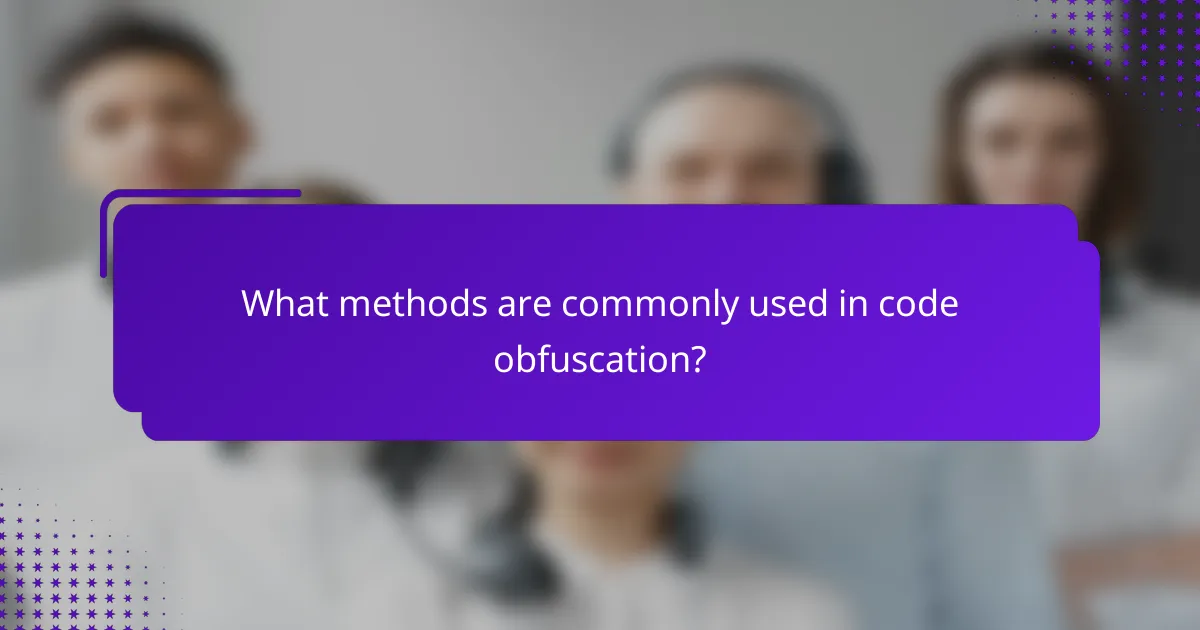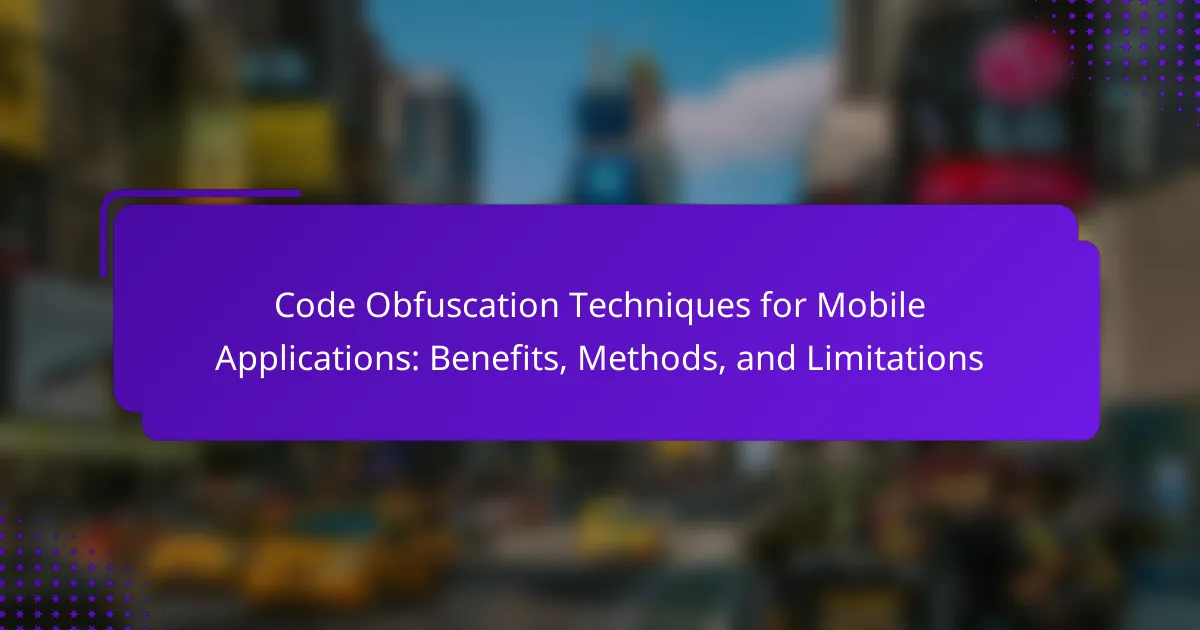Code obfuscation techniques for mobile applications are methods designed to protect source code from reverse engineering by making it difficult to understand while preserving functionality. Key techniques include renaming variables and methods to meaningless labels, control flow obfuscation that alters the program’s logical flow, and string encryption that secures sensitive data. While these methods enhance security by complicating unauthorized access, they also have limitations, such as potential performance impacts and the possibility of being reversed by skilled attackers. This article explores the benefits, methods, and limitations of code obfuscation, providing a comprehensive overview of its role in mobile application security.

What are Code Obfuscation Techniques for Mobile Applications?
Code obfuscation techniques for mobile applications are methods used to protect source code from reverse engineering. These techniques make the code difficult to understand while maintaining its functionality. Common techniques include renaming variables and methods to meaningless labels. Additionally, control flow obfuscation alters the logical flow of the program. String encryption hides sensitive data within the code. Code splitting divides the application into smaller parts to complicate understanding. These methods enhance security by increasing the effort required for unauthorized access. Studies show that effective obfuscation can significantly deter attackers and protect intellectual property.
Why is code obfuscation important for mobile applications?
Code obfuscation is crucial for mobile applications to protect sensitive code from reverse engineering. It makes the codebase difficult to understand for unauthorized users. This protection helps safeguard intellectual property and proprietary algorithms. A study by the International Journal of Information Security highlights that obfuscation can reduce code readability by up to 90%. By complicating the code structure, it deters attackers from exploiting vulnerabilities. Additionally, obfuscation minimizes the risk of code tampering and unauthorized modifications. Overall, it enhances the security posture of mobile applications against various cyber threats.
How does code obfuscation enhance security?
Code obfuscation enhances security by making the source code difficult to understand for unauthorized users. It transforms readable code into a complex format that retains functionality but obscures logic and structure. This process helps protect intellectual property by preventing reverse engineering. Additionally, it reduces the risk of exploitation by obscuring vulnerabilities. Studies have shown that obfuscation can significantly increase the effort required for attackers to analyze and compromise applications. For instance, a research paper titled “Code Obfuscation: A Survey” by R. K. Sharma and A. K. Jain details various techniques that demonstrate the effectiveness of obfuscation in safeguarding software.
What are the potential risks of not using code obfuscation?
Not using code obfuscation increases the risk of code exposure. This can lead to unauthorized access to source code. Attackers may easily reverse-engineer applications without obfuscation. They can extract sensitive information, such as API keys and user data. The lack of obfuscation makes it easier for competitors to copy proprietary algorithms. Security vulnerabilities may remain unaddressed if attackers analyze the code. Malware can be injected into applications more easily without obfuscation. Overall, the absence of code obfuscation significantly elevates the security risks for mobile applications.
What are the main types of code obfuscation techniques?
The main types of code obfuscation techniques include renaming, control flow obfuscation, and data obfuscation. Renaming involves changing variable and function names to meaningless identifiers. This makes the code harder to understand while maintaining its functionality. Control flow obfuscation alters the logical flow of the program. It does this by adding misleading paths and altering the structure of the code. Data obfuscation involves encrypting or altering the data used within the application. This prevents easy access to sensitive information. Each technique serves to protect the code from reverse engineering and unauthorized access.
How does control flow obfuscation work?
Control flow obfuscation works by altering the execution paths of a program to make it difficult to understand. This technique modifies the program’s control flow graph without changing its external behavior. It introduces misleading or redundant paths that do not affect the program’s output. For example, it may insert fake conditional statements or loops. These modifications confuse reverse engineers attempting to analyze the code. By obscuring the logical flow, it increases the effort required to understand the program. Studies have shown that control flow obfuscation significantly raises the complexity of static analysis. This makes it a valuable technique in protecting mobile applications from unauthorized access and tampering.
What is data obfuscation and how is it applied?
Data obfuscation is the process of deliberately making data difficult to understand. It is applied to protect sensitive information from unauthorized access or misuse. Techniques include scrambling data, using encryption, or replacing original data with fake data. These methods ensure that even if data is intercepted, it remains unintelligible. Data obfuscation is commonly used in software development, particularly in mobile applications. Its primary goal is to enhance data security and privacy. By obscuring data, organizations reduce the risk of data breaches and maintain compliance with regulations.
What role does symbol renaming play in code obfuscation?
Symbol renaming is a critical technique in code obfuscation. It involves changing the names of variables, functions, and classes to meaningless identifiers. This process makes the code harder to understand for anyone attempting to reverse-engineer it. Symbol renaming obscures the original intent and functionality of the code. For instance, a function named ‘calculateTotal’ might be renamed to ‘a1b2c3’. This transformation complicates the analysis of the code structure. Studies show that effective symbol renaming can significantly increase the difficulty of static analysis. As a result, it serves as a valuable layer of protection against unauthorized access and exploitation.
What are the benefits of using code obfuscation techniques?
Code obfuscation techniques enhance software security by making the code difficult to understand. They protect intellectual property by preventing reverse engineering. Obfuscation also helps in safeguarding sensitive data within the application. It can deter attackers from exploiting vulnerabilities. The use of these techniques can lead to reduced risk of code tampering. Additionally, obfuscation can help maintain competitive advantage by hiding proprietary algorithms. According to a study by the University of Maryland, code obfuscation significantly increases the difficulty of unauthorized code analysis. This demonstrates the effectiveness of obfuscation in protecting mobile applications.
How does code obfuscation protect intellectual property?
Code obfuscation protects intellectual property by making source code difficult to understand. It transforms code into a version that retains functionality but obscures its logic and structure. This complexity hinders reverse engineering efforts. As a result, unauthorized users struggle to replicate or steal the underlying algorithms and business logic. Studies show that effective obfuscation can significantly increase the time and resources required for code analysis. For example, obfuscation techniques can reduce code readability by over 90%. This added layer of security safeguards proprietary technology and maintains competitive advantage.
What impact does code obfuscation have on application performance?
Code obfuscation can negatively impact application performance. It introduces additional processing overhead due to the complexity of the obfuscated code. This complexity can lead to slower execution times. Furthermore, obfuscation may increase the size of the application binary. Larger binaries can result in longer load times. In some cases, obfuscation can hinder optimization techniques used by compilers. This may lead to less efficient code execution. Overall, while code obfuscation enhances security, it often compromises performance.

What methods are commonly used in code obfuscation?
Common methods used in code obfuscation include renaming, control flow obfuscation, and string encryption. Renaming involves changing variable and function names to meaningless identifiers. This makes the code harder to read and understand. Control flow obfuscation alters the program’s control flow to confuse reverse engineering efforts. It can involve adding dummy code or changing the structure of loops and branches. String encryption protects sensitive data by encrypting strings in the code. This prevents easy access to readable information. These methods collectively enhance the security of mobile applications by complicating unauthorized analysis.
How do automated tools assist in code obfuscation?
Automated tools assist in code obfuscation by transforming source code into a version that is difficult to understand. These tools use techniques such as renaming variables and functions to meaningless labels. They can also alter the control flow of the program. This makes reverse engineering more challenging for potential attackers. Automated tools can process large codebases quickly, saving developers time. Additionally, they often provide various levels of obfuscation, allowing customization based on security needs. Studies show that effective obfuscation can significantly reduce the risk of code exploitation.
What are some popular code obfuscation tools available?
Some popular code obfuscation tools include ProGuard, DexGuard, and Allatori. ProGuard is widely used for Android applications to shrink, optimize, and obfuscate code. DexGuard offers advanced features for Android security, including encryption and string obfuscation. Allatori is known for its Java obfuscation capabilities, providing various techniques to protect code against reverse engineering. These tools are effective in enhancing the security of mobile applications by making the code difficult to understand.
How do developers choose the right tool for their needs?
Developers choose the right tool for their needs by evaluating specific requirements and compatibility. They assess the features of the tool against project goals. Developers consider factors such as ease of use, support, and documentation. Performance and scalability are also critical considerations. Cost-effectiveness plays a significant role in the decision-making process. Developers often seek community feedback and reviews for insights. They may conduct trials or proofs of concept to test functionality. Ultimately, the chosen tool must align with both current and future project demands.
What manual techniques can be employed for effective code obfuscation?
Manual techniques for effective code obfuscation include renaming variables and functions to meaningless names. This makes understanding the code more challenging. Another technique is altering control flow by adding redundant code or changing the sequence of operations. This disrupts the logical flow of the program. Additionally, removing comments and formatting can obscure the code’s purpose. Encoding strings and data can also hide sensitive information. Using complex data structures can further complicate reverse engineering efforts. These methods collectively enhance the security of the code. They make it difficult for attackers to analyze and exploit vulnerabilities.
How can developers implement manual obfuscation strategies?
Developers can implement manual obfuscation strategies by altering the code structure to make it less understandable. They can rename variables and methods to meaningless strings. This reduces the clarity of the code. Developers can also insert redundant code that does not affect functionality. This further complicates the code without altering its behavior. Another strategy is to change control flow structures, making the logic harder to follow. Developers can use encryption for sensitive strings in the code. These strategies collectively enhance the security of the application against reverse engineering. Manual obfuscation can significantly deter unauthorized access to the codebase.
What are the best practices for manual code obfuscation?
The best practices for manual code obfuscation include using meaningful variable names and modularizing code. Meaningful variable names make the code easier to understand but should be altered to obscure their purpose. Modularizing code helps isolate functionality, making it harder to reverse-engineer. Additionally, employing control flow obfuscation can confuse the logic of the code. This involves altering the flow of execution without changing the output. Another practice is to remove unused code and comments to reduce the information available to potential attackers. Finally, using string encryption can protect sensitive data within the code. These practices collectively enhance the security of the application against reverse engineering.

What are the limitations of code obfuscation techniques?
Code obfuscation techniques have several limitations. They can be reversed by skilled attackers using deobfuscation tools. This means that obfuscation does not guarantee complete protection of code. Performance may also be impacted, as obfuscation can introduce additional processing overhead. Additionally, obfuscation can complicate debugging and maintenance processes. Some obfuscation methods may not provide sufficient security against advanced reverse engineering techniques. Furthermore, obfuscation can lead to compatibility issues with certain platforms or environments. Lastly, it can create a false sense of security, leading developers to neglect other essential security practices.
What challenges do developers face when implementing code obfuscation?
Developers face several challenges when implementing code obfuscation. One major challenge is the balance between security and performance. Obfuscation can lead to increased execution time and memory usage. This can negatively impact the user experience in mobile applications. Another challenge is the complexity of maintaining obfuscated code. Developers may find it difficult to debug or update their applications. Additionally, obfuscation techniques can sometimes be bypassed by skilled attackers. This means that the effectiveness of obfuscation can be limited. There is also the challenge of ensuring compatibility with various platforms. Different operating systems may react differently to obfuscated code. Overall, these challenges can complicate the implementation of effective code obfuscation strategies.
How does obfuscation affect debugging and maintenance?
Obfuscation complicates debugging and maintenance processes. It transforms code to make it difficult to understand. This makes identifying errors or bugs more challenging for developers. Debugging tools may not effectively interpret obfuscated code. As a result, developers spend more time deciphering code logic. Maintenance becomes cumbersome due to the lack of clear variable names and structures. This can lead to increased development costs and longer project timelines. Studies indicate that obfuscation increases the cognitive load on developers, hindering productivity.
What are the potential performance trade-offs of obfuscation?
Obfuscation can lead to performance trade-offs in mobile applications. It often increases the execution time of code due to added complexity. The obfuscation process can also result in larger file sizes, impacting download and storage efficiency. Additionally, debugging becomes more difficult, which can slow down development and maintenance. According to a study by Kaur et al. (2020), obfuscated code can introduce runtime overhead, affecting user experience. This overhead varies based on the obfuscation technique used. Overall, while obfuscation enhances security, it may compromise performance efficiency.
Are there legal implications associated with code obfuscation?
Yes, there are legal implications associated with code obfuscation. Code obfuscation can lead to potential violations of copyright law. If obfuscation is used to conceal the original source code, it may infringe on the rights of the original creator. Additionally, obfuscation can complicate compliance with software licensing agreements. Some licenses require transparency in code usage and modification. Furthermore, using obfuscation to hide malicious code can lead to legal consequences. Authorities may pursue cases under anti-cybercrime laws if obfuscation is used for illegal activities. Overall, while obfuscation can protect intellectual property, it also carries legal risks that must be carefully considered.
How do copyright laws intersect with code obfuscation practices?
Copyright laws protect original works, including software code. Code obfuscation practices involve altering code to make it difficult to understand while preserving functionality. This practice can serve as a method to protect intellectual property under copyright law. However, it raises legal questions regarding the extent of protection. Courts have ruled that obfuscation does not eliminate copyright infringement liability. For instance, if someone deobfuscates code and copies it, copyright infringement may still occur. Thus, while obfuscation can deter reverse engineering, it does not guarantee protection from copyright violations.
What ethical considerations should developers keep in mind?
Developers should prioritize user privacy and data protection. This includes implementing strong security measures to safeguard personal information. Ethical considerations also encompass transparency in data usage. Users should be informed about how their data is collected and utilized. Additionally, developers must avoid creating misleading or harmful applications. Ethical practices promote trust and integrity in the software development process. Compliance with regulations, such as GDPR, is also essential. This ensures that developers respect user rights and adhere to legal standards. By prioritizing these considerations, developers contribute to a responsible digital environment.
What are the best practices for implementing code obfuscation in mobile applications?
The best practices for implementing code obfuscation in mobile applications include using a robust obfuscation tool. These tools should provide multiple obfuscation techniques such as renaming, control flow obfuscation, and string encryption. Regularly updating the obfuscation techniques is crucial to counteract new reverse engineering methods. Integrating obfuscation into the build process ensures consistency and reduces manual errors. Testing the application after obfuscation is important to ensure functionality remains intact. Additionally, combining obfuscation with other security measures, like encryption and secure coding practices, enhances overall security. Monitoring for vulnerabilities post-release can help identify and mitigate risks.
Code obfuscation techniques for mobile applications are methods used to protect source code from reverse engineering, enhancing security by making the code difficult to understand while maintaining functionality. Key techniques include renaming variables, control flow obfuscation, and data obfuscation, all aimed at safeguarding intellectual property and reducing the risk of unauthorized access. The article explores the importance of code obfuscation, its benefits, common methods, and potential limitations, including impacts on performance and legal implications. Additionally, it discusses best practices for effective implementation and the challenges developers face in maintaining obfuscated code.
